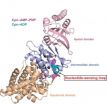(Press-News.org) In the crash-car derby between heavy and light isotopes vying for the coolest spots as magma turns to solid rock, weightier isotopes have an edge, research led by Case Western Reserve University shows.
This tiny detail may offer clues to how igneous rocks form.
As molten rock cools along a gradient, atoms want to move towards the cool end. This happens because hotter atoms move faster than cooler atoms and, therefore, hotter atoms move to the cool region faster than the cooler atoms move to the hot region.
Although all isotopes of the same element want to move towards the cool end, the big boys have more mass and, therefore, momentum, enabling them to keep moving on when they collide along the way.
"It's as if you have a crowded, sealed room of sumo wrestlers and geologists and a fire breaks out at one side of the room," said Daniel Lacks, chemical engineering professor and lead author of the paper. "All will try to move to the cooler side of the room, but the sumo wrestlers are able to push their way through and take up space on the cool side, leaving the geologists on the hot side of the room."
Lacks worked with former postdoctoral researcher Gaurav Goel and geology professor James A. Van Orman at Case Western Reserve; Charles J. Bopp IV and Craig C. Lundstrum, of University of Illinois, Urbana; and Charles E. Lesher of the University of California at Davis. They described their theory and confirming mathematics, computer modeling, and experiments in the current issue of Physical Review Letters.
Lacks, Van Orman and Lesher also published a short piece in the current issue of Nature, showing how their findings overturn an explanation based on quantum mechanics, published in that journal last year.
"The theoretical understanding of thermal isotope separation in gases was developed almost exactly 100 years ago by David Enskog, but there is as yet not a similar full understanding of this process in liquids," said Frank Richter, who is the Sewell Avery Distinguished Professor at the University of Chicago and a member of the National Academy of Sciences. He was not involved in the research. "This work by Lacks et al. is an important step towards remedying this situation."
This separation among isotopes of the same element is called fractionation.
Scientists have been able to see fractionation of heavy elements in igneous rocks only since the 1990s, Van Orman said. More sensitive mass spectrometers showed that instead of a homogenous distribution, the concentration ratio of heavy isotopes to light isotopes in some igneous rocks was up to 0.1 percent higher than in other rocks.
One way of producing this fractionation is by temperature.
To understand how this happens, the team of researchers created a series of samples made of molten magnesium silicate infused with elements of different mass, from oxygen on up to heavy uranium.
The samples, called silicate melts, were heated at one end in a standard lab furnace, creating temperature gradients in each. The melts were then allowed to cool and solidify.
The scientists then sliced the samples along gradient lines and dissolved the slices in acid. Analysis showed that no matter the element, the heavier isotopes slightly outnumbered the lighter at the cool end of the gradient.
Computer simulations of the atoms, using classical mechanics, agreed with the experimental results.
"The process depends on temperature differences and can be seen whether the temperature change across the sample is rapid or gradual," Lacks said.
Thermal diffusion through gases was one of the first methods used to separate isotopes, during the Manhattan Project. It turns out that isotope fractionation through silicate liquids is even more efficient than through gases.
"Fractionation can occur inside the Earth wherever a sustained temperature gradient exists," Van Orman said. "One place this might happen is at the margin of a magma chamber, where hot magma rests against cold rock. Another is nearly 1,800 miles inside the Earth, at the boundary of the liquid core and the silicate mantle."
The researchers are now adding pressure to the variables as they investigate further. This work was done at atmospheric pressure but where the Earth's core and mantle meet, the pressure is nearly 1.4 million atmospheres.
Lacks and Van Orman are unsure whether high pressure will result in greater or lesser fractionation. They can see arguments in favor of either.
INFORMATION: END
From spaghetti-like sea anemones to blobby jellyfish to filigreed oak trees, each species in nature is characterized by a unique size and shape. But the evolutionary changes that produce the seemingly limitless diversity of shapes and sizes of organisms on Earth largely remains a mystery. Nevertheless, a better understanding of how cells grow and enable organisms to assume their characteristic sizes and shapes could shed light on diseases that involve cell growth, including cancer and diabetes.
Providing new information about the evolution of the diversity of sizes and ...
For decades, scientists have understood that there is a genetic component to intelligence, but a new Harvard study has found both that most of the genes thought to be linked to intelligence are probably not in fact related to it, and identifying intelligence's specific genetic roots may still be a long way off.
Led by David I. Laibson '88, the Robert I. Goldman Professor of Economics, and Christopher F. Chabris '88, PhD '99, Assistant Professor of Psychology at Union College, a team of researchers examined a dozen genes using large data sets that included both intelligence ...
PHILADELPHIA -- Would you be able to find an automated external defibrillator if someone's life depended on it? Despite an estimated one million AEDs scattered around the United States, the answer, all too often when people suffer sudden cardiac arrests, is no.
In a Perspective piece published online this week in the journal Circulation: Cardiovascular Quality Outcomes, two researchers from the Perelman School of Medicine at the University of Pennsylvania outline the tremendous potential associated with greater utilization of AEDs in public places and a method to find ...
LOS ALAMOS, New Mexico, February 24, 2012—A multinational team of scientists has developed a process for creating glass-based, inorganic light-emitting diodes (LEDs) that produce light in the ultraviolet range. The work, reported this week in the online Nature Communications, is a step toward biomedical devices with active components made from nanostructured systems.
LEDs based on solution-processed inorganic nanocrystals have promise for use in environmental and biomedical diagnostics, because they are cheap to produce, robust, and chemically stable. But ...
CLEMSON — A study of X-rays emitted a long time ago in a galaxy far, far away has unmasked a stellar mass black hole in Andromeda, a spiral galaxy about 2.6 million light-years from Earth.
Two Clemson University researchers joined an an international team of astronomers, including scientists at Germany's Max Planck Institute for Extraterrestrial Physics, in publishing their findings in a pair of scientific journals this week.
Scientists had suspected the black hole was possible since late 2009 when an X-ray satellite observatory operated by the Max Planck Institute ...
NEW YORK – February 24, 2012 – A forthcoming article in the Journal of Consumer Research by Professor Michel Tuan Pham, Kravis Professor of Business, Marketing, Columbia Business School; Leonard Lee, Associate Professor, Marketing, Columbia Business School; and Andrew Stephen, PhD '09, currently Assistant Professor of Business Administration, Joseph M. Katz Graduate School of Business, University of Pittsburgh, finds that a higher trust in feelings may result in more accurate predictions about a variety of future events. The research will also be featured in Columbia Business ...
The gold standard for nanotechnology is nature's own proteins. These biomolecular nanomachines – macromolecules forged from peptide chains of amino acids - are able to fold themselves into a dazzling multitude of shapes and forms that enable them to carry out an equally dazzling multitude of functions fundamental to life. As important as protein folding is to virtually all biological systems, the mechanisms behind this process have remained a mystery. The fog, however, is being lifted.
A team of researchers with the U.S. Department of Energy (DOE)'s Lawrence Berkeley ...
Patients with heart disease who took cholesterol-lowering statins were significantly less likely to develop depression than those who did not, in a study by Mary Whooley, MD, a physician at the San Francisco VA Medical Center and a professor of medicine at the University of California, San Francisco.
The study was published electronically in the Journal of Clinical Psychiatry (February 21, 2012).
Whooley and her research team evaluated 965 heart disease patients for depression, and found that the patients who were on statins were significantly less likely to be clinically ...
NEW YORK – February 24, 2012 – A recent study in the Review of Financial Studies proposes a new, valuation-based measure of equity market segmentation. Equity market segmentation occurs when stocks of similar risk in different countries are priced differently. The study, by Columbia Business School Professor Geert Bekaert, Chazen Senior Scholar at The Jerome A. Chazen Institute of International Business at Columbia Business School and the Leon G. Cooperman Professor of Finance and Economics, uncovers the factors that cause variation in market segmentation, both through ...
Prehistoric Eurasian nomads are commonly perceived as horse riding bandits who utilized their mobility and military skill to antagonize ancient civilizations such as the Chinese, Persians, and Greeks. Although some historical accounts may support this view, a new article by Dr. Michael Frachetti (Washington University, St. Louis) illustrates a considerably different image of prehistoric pastoralist societies and their impact on world civilizations more than 5000 years ago.
In the article, recently published in the February issue of Current Anthropology, Frachetti argues ...




